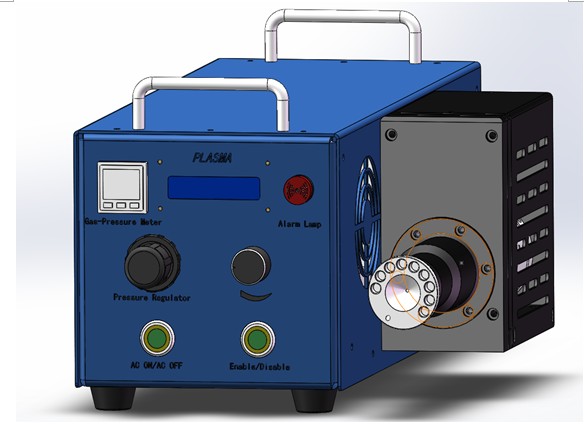Overview
Plasma cleaning machine (plasma cleaner) , also known as plasma cleaning machine, or a plasma surface treatment device, is a new high technology, to achieve using conventional plasma cleaning method can not be achieved. A plasma, like a solid, a liquid, or a gas, is a state of matter, also called the fourth state of matter, and is not a common solid-liquid three-state. Applying enough energy to the gas to ionize it becomes a plasma state. The "active" components of the plasma include: ions, electrons, atoms, reactive groups, excited states of nuclides (metastasis), photons, and the like. Plasma cleaners use the properties of these active components to treat the surface of the sample for cleaning, coating, and more. The biggest feature of plasma cleaning technology is that it can be processed regardless of the substrate type of the object to be processed. For metals, semiconductors, oxides and most polymer materials, such as polypropylene, polyester, polyimide, polychlorinated Ethane, epoxy, and even Teflon are well handled and can be cleaned in whole and in part as well as in complex structures. Through the plasma cleaning machine, it can improve the wetting ability of the surface of the material, enabling a variety of materials to be coated, plated, etc., to enhance adhesion, bonding force, and remove organic pollutants, oil or grease.

The Principle of Activation Cleaning
A , physical role: particle bombardment on the surface of the material
A large number of active particles in the plasma, such as a large number of ions, excited molecules, and free radicals, act on the surface of the solid sample, which not only removes the original contaminants and impurities, but also produces an etching effect to roughen the surface of the sample. Many fine and uniform topography are formed, which increases the specific surface of the sample and improves the adhesion of the solid surface.
B , cross-linking effect: activation key energy
The energy of the particles in the plasma is between 0 and 20 eV, and most of the bonds in the polymer are between 0 and 10 eV. Therefore, after the plasma acts on the solid surface, the original chemical bonds on the solid surface can be broken. Free radicals form a network of crosslinked structures with these bonds, greatly activating surface activity.
C , chemical action : formation of new functional groups
If a reactive gas is introduced into the discharge gas, a new functional group such as a hydrocarbon group, an amino group, a carboxyl group or the like is introduced, and a complicated chemical reaction occurs on the surface of the activated material, and these functional groups are active groups, which significantly improve the surface activity of the material.
Technical Parameters :
Name
|
Spray type AP plasma surface treatment system
|
Model (Model)
|
DSX-APO-RP1020D
|
Power Supply
|
220V/AC, 50/60Hz
|
Power (Power)
|
800W/25KHz
|
Processing Height
|
5-15mm
|
Processing Width
|
20-80mm (Option)
|
Internal Control Mode
|
digital control
|
External Control Mode
|
RS232 digital communication port, analog control port
|
Working Gas
|
Compressed Air (0.4Mpa)
|
Nozzle specification
|
Length 180mm, diameter 48mm
|
Nozzle size (without nozzle part)
|
180*85*155 length, width and height
|
Host controller size
|
500*185*170mm length, width and height
|
Controller weight
|
4kg
|
Nozzle weight
|
2.5kg
|
Advantages :
1. A variety of nozzles are available for different occasions to meet different products and processing environments.
2. The device is small in size, easy to carry and move, saving customers space.
3. In-Line can be installed in the customer equipment production line to reduce customer input costs
4. Long service life, low maintenance and repair cost, easy for customer cost control
5. Environmental protection technology: The plasma action process is a gas - solid phase dry reaction , which does not consume water resources, does not require the addition of chemical agents , and has no pollution to the environment.
6. Wide applicability: suitable for granules, powdery products , such as fine coal powder, glass beads materials can be handled well;
Function :
Plasmas include atoms, molecules, ions, electrons, reactive groups, excited atoms, activated molecules, and free radicals. These particles have high energy and activity, and their energy is sufficient to destroy almost all chemical bonds on any exposed surface. When a chemical reaction is caused and some chemical bonds are opened, a highly active substance such as an oxygen atom is bonded, so that the hydrophilicity of the surface of the material is greatly improved, and a new chemical reaction is formed on the organic macromolecule such as oil on the surface of the material to form a gaseous small molecule. For example, carbon dioxide, water vapor and other gaseous substances are emitted in the air to achieve molecular level cleaning of the surface of the material.
Application :
1> Mainly used in the electronic industry, mobile phone shell printing, coating, dispensing and other pre-treatment, surface treatment of mobile phone screen
2> Aerospace electrical connector surface cleaning for defense industry
3> Screen printing and transfer pre-processing in the general industry
In the rubber and plastics industry, the rubber and plastics industry, the electronics industry, the defense industry, the medical industry, the textile fiber industry.

No comments:
Post a Comment